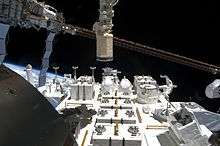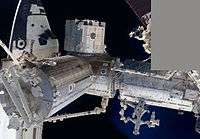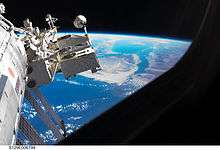Kibo (ISS module)



The Japanese Experiment Module (JEM), also known with the nickname Kibo (きぼう Kibō, Hope), is a Japanese science module for the International Space Station (ISS) developed by JAXA. It is the largest single ISS module. The first two pieces of the module were launched on Space Shuttle missions STS-123 and STS-124. The third and final components were launched on STS-127.[1]
Components
Kibō consists of six major elements: 1) Pressurized Module (PM), 2) Exposed Facility (EF), 3) Experiment Logistics Module-Pressurized Section (ELM-PS), 4) Experiment Logistics Module-Exposed Section (ELM-ES), 5) Japanese Experiment Module Remote Manipulator System (JEMRMS), and 6) Inter-orbit Communication System (ICS).[2]
Pressurized Module

The Pressurized Module (PM) is the core component connected to the port hatch of the Node 2 Module. It is cylindrical in shape and contains twenty-three International Standard Payload Racks (ISPRs), ten of which are dedicated to science experiments while the remaining 13 are dedicated to Kibo’s systems and storage.[3] The racks are placed 6-6-6-5 along the four walls of the module. The end of the JEM-PM has an airlock and two window hatches. The Exposed Facility, Experiment Logistics Module and the Remote Manipulator System all connect to the pressurized module. Kibo is also the location for many of the press conferences that take place on board the station.
Exposed Facility

The Exposed Facility (EF), also known as "Terrace", is located outside the port cone of the PM (which is equipped with an airlock). The EF has 12 EFU (Exposed Facility Unit) ports that attach to PIU (Payload Interface Unit) connectors on EF-EEUs (EF-Equipment Exchange Units). All experiment payloads are fully exposed to the space environment. For proper functioning of these experiments, the payload requires an ORU (Orbital Replacement Unit) which consists of the EPS (Electrical Power System), CT (Communications & Tracking) and the TCS (Thermal Control System). Of the 12 ORUs, eight are replaceable by the JEMRMS while the other four are EVA-replaceable.
Experiment Logistics Module
The Experiment Logistics Module (ELM) includes two sections:
- The Japanese Experiment Logistics Module, Pressurized Section (ELM-PS) –- also called the JLP –- is a pressurized addition to the PM. The module is a storage facility that provides storage space for experiment payloads, samples and spare items.[4]
- The unpressurized (external) section (ELM-ES) serves the EF as a storage and transportation module.
Remote Manipulator System
The Remote Manipulator System (JEMRMS) is a 10m long robotic arm, mounted at the port cone of the PM, intended to service the EF and to move equipment from and to the ELM. The RMS control console was launched while inside the ELM-PS. The main arm was launched with the PM. The "Small Fine Arm", is 2m long and attaches to the end effector of the main arm, was launched aboard.[5] The free end of the arm is able to use the type of grapple fixtures that the Canadarm2 uses.[6]
Launch sequence


NASA launched the JEM complex over three flights using the Space Shuttle. The shuttle had a large payload bay which carried the modules into orbit along with the crew. This is in contrast to the Russian modules, which are launched into orbit on multistage Proton rockets and then rendezvous and dock with the station automatically. On 12 March 2007, the Experiment Logistics Module Pressurized Section (ELM-PS), the main laboratory, arrived at the Kennedy Space Center (KSC) from Japan.[7] It was stored in the Space Station Processing Facility until launched into orbit aboard Space Shuttle Endeavour as part of the STS-123 mission.[8]

At first the ELM-PS, the small cargo bay, was connected to a temporary location on the Harmony module (Node 2) and later, on 6 June 2008, was moved to its final destination, or berthing location, on top (zenith) of the main laboratory. On 30 May 2003, the Pressurized Module (PM) arrived at KSC from Japan.[9] It was stored at the Space Station Processing Facility until launched into orbit aboard Space Shuttle Discovery as part of the STS-124 mission.[10] On 3 June 2008 the PM was attached to the Harmony module. The EF and ELM-ES arrived at KSC on 24 September 2008.[11] The Exposed Facility (EF) and ELM-ES were launched on STS-127, on 15 July 2009.[12] The ELM-ES was brought back to Earth at the end of the mission. The assembly of the EF was completed during the fifth spacewalk of the mission.[13]
Specifications

Kibō is the largest single ISS module.
- Pressurized Module[14]
- Length: 11.19 m (36.7 ft)
- Diameter: 4.39 m (14.4 ft)
- Mass: 15,900 kg (35,100 lb)
- Experiment Logistics Module[15]
- Length: 4.21 m (13.8 ft)
- Diameter: 4.39 m (14.4 ft)
- Mass: 8,386 kg (18,488 lb)
Current external experiments on Kibo
- MAXI - X-ray astronomy from 0.5 to 30 keV[16]
- ICS-EF - Inter-orbit Communication System - Exposed Facility, Japanese communication system.
- SEDA-AP (Space Environment Data Acquisition equipment-Attached Payload) - Measures neutrons, plasma, heavy ions, and high-energy light particles in the station's orbit.
- HREP (Hyperspectral Imager for the Coastal Ocean (HICO) & Remote Atmospheric & Ionospheric Detection System (RAIDS) Experimental Payload)
- CATS - Cloud-Aerosol Transport System (LiDAR, NASA)
- CALET - CALorimetric Electron Telescope (JAXA), Observation for high energy. Launched aboard HTV-5.[17] Mass: 2500 kg[18]
- NREP - Nanoracks External Platform is inside the ISS when the first experiments arrive it will be transferred to the external facility through the airlock.
Deorbited with HTV-5:
- SMILES - Observes and monitors very weak sub-millimeter wave emission lines of trace gas molecules in the stratosphere[19]
- MCE - Multi-mission Consolidated Equipment (NASA)
Planned external experiments on Kibo

- OCO-3 - Monitoring of carbon dioxide in the Earth's atmosphere using a flight spare from OCO-2. To be launched in 2016 aboard a SpaceX Dragon capsule.[20]
- NICER - Neutron-star Interior Composition Explorer (NASA), X-ray telescope, planned for SpaceX CRS-11 sometime in 2016.
Current internal experiments on Kibo

Japanese:
- RYUTAI Rack - Fluid Physics Experiment Facility (FPEF), Solution Crystallization Observation Facility (SCOF), Protein Crystallization Research Facility (PCRF), Image Processing Unit (IPU)
- SAIBO Rack - Cell Biology Experiment Facility (CBEF), Clean Bench (CB)
- KOBAIRO Rack - Gradient Heating Furnace (GHF)
- MPSR-1 - Multi-Purpose Small payload Rack
- MPSR-2 - Multi-Purpose Small payload Rack, housing Electrostatic Levitating Furnace (ELF)
American:
- EXPRESS Rack 4 - Biotechnology Specimen Temperature Controller (BSTC), Gas Supply Module (GSM), Space Acceleration Measurement System-II (SAMS-II), Biotechnology Specimen Temperature Controller (BSTC), Nanoracks NanoLab
- EXPRESS Rack 5
- MELFI-1 two Minus eighty degree freezer racks.
Planned internal experiments on Kibo
Parts
 Pressurized Module |
.jpg) Experiment Logistics Module |
 Exposed Facility |
.jpg) Experiment Logistics Module |
 Remote Manipulator System |
See also
References
- ↑ Kamiya, Setsuko, "Japan a low-key player in space race", Japan Times, 30 June 2009, p. 3.
- ↑ http://kibo.jaxa.jp/en/about/
- ↑ "NASA — Kibo Japanese Experiment Module". NASA.
- ↑ "STS-123 MCC STATUS REPORT #11". NASA. 2008-03-16.
- ↑ "Remote Manipulator System". JAXA.
- ↑ http://iss.jaxa.jp/en/htv/mission/htv-1/presskit/htv-1_presskit.pdf pg19
- ↑ "Shipping of the Kibo ELM-PS, Kibo RMS and Kibo experiment racks". JAXA.
- ↑ "NASA's Shuttle Endeavour Begins Mission to the Space Station". NASA.
- ↑ "Kibo PM arrival in USA". JAXA.
- ↑ "NASA's Shuttle Discovery Launches With Japanese Laboratory". NASA.
- ↑ "Kennedy Media Gallery — PHOTO NO: KSC-08PD-2924". NASA.
- ↑ "STS-127 mission page".
- ↑ William Harwood for CBS news (27 July 2009). "Endeavour crew completes fifth and final spacewalk". spaceflightnow.com. Retrieved 2009-07-29.
- ↑ "STS-124 Press Kit" (PDF). NASA.
- ↑ "STS-123 Press Kit" (PDF). NASA.
- ↑ "Monitor of All-sky X-ray Image: MAXI". JAXA.
- ↑ "About the cooperation of JAXA and ASI in the development of CALET". JAXA. 10 June 2013. Retrieved 10 January 2014.
- ↑ The CALET project for investigating high energy universe
- ↑ "Superconducting Submillimeter-wave Limb-emission Sounder: SMILES". JAXA.
- ↑ OCO-3 instrument
External links
| Wikimedia Commons has media related to Japanese Experiment Module. |
- ISS facility catalog
- The Future of Hope - Kibo Prologue to the Future - STS-127 2J/A Mission on JAXA Channel
- Animated video of Remote Manipulator System Small Fine Arm
- KIBO at JAXA site
- KIBO Handbook (JAXA)
